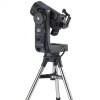Meade LS 6 inch User Manual - Page 29
Advanced Ls Features
 |
View all Meade LS 6 inch manuals
Add to My Manuals
Save this manual to your list of manuals |
Page 29 highlights
ADVANCED LS FEATURES Two Star Alt Az Alignment 1. Select Alt. Az. 2 Star alignment from the Align menu to begin two star alignment. 2. "Automatic Alignment" displays. The system now performs the following routines (press any ETXLS key to abort Automatic Alignment). Caution: As the telescope performs the following operations, it will swing and rotate. Keep a safe distance from the telescope. The telescope now finds the level and tilt position of the telescope, and also detects where true North is. It may not actually level or tilt the telescope or point to North - it is just detecting these positions. This may take a minute or two. a. Attempts a "GPS Fix". The GPS receiver attempts to acquire and sync up with signals from GPS satellite system. "Getting GPS Fix" displays Note: Press Mode key to abort the GPS fix. You will then be prompted to enter the time, date and location. b. Detects "level" of the base of the telescope; finds tilt and tip. To detect level, LS must calculate "level" at three compass points. LS also determines the positioning (i.e., tilt and tip) of the optical tube. c. Finds North. Locates magnetic North, then calculates true North. NOTE: After performing these operations, LS now knows: • The telescope's limiting positions • Where level is for the telescope • The location of true North • The observing site's location • The date and time d. Once the level, tilt and North are detected, the telescope will "GO TO" 2 alignment stars. The telescope will go to these stars in order to orient itself to the sky. Once it has done this, it will be able to point to any one of nearly 100,00 objects in its database. e. "Automatic Alignment: Selecting Star" and "Slewing" display. When it is close to the alignment star "Center Brightest Star: Press "ENTER"" displays. When the telescope slews to the first star, it may not appear in the field of view in the eyepiece. Use the Red Dot Finder (Pg. 12, Fig. 2, 16) to locate the star. The alignment star will be easy to recognize - it will be the brightest star in the area of the sky where the telescope is pointing. Use the Arrow keys to center the alignment star in the eyepiece. When the alignment star is centered, press "ENTER". Repeat the procedure for the second alignment. f. The telescope now slews to the second alignment star. LS displays "Center Brightest Star". g. "Press "ENTER"" displays. Use the Arrow keys to center the alignment star in the eyepiece. When the second alignment star is centered, press "ENTER". h. "Alignment successful" displays. If "Alignment Unsuccessful" displays, perform the procedure again. NOTE: If you have an obstruction, such as a tree or a building blocking your view of the alignment star, or if you have any doubts at all about the star that has been chosen, no problem. Just press the SCROLL DOWN key and LS will find another star to align upon. NOTE: The selected alignment stars may vary by date and time. All that is required is for the observer to center the selected stars in the eyepiece when prompted. IMPORTANT NOTE: The "Telescope: Mount" option of the Setup menu is set to "Alt/Az" as the default alignment by the factory. The example presented in this section assumes that you are performing an alignment procedure for the first time with your telescope and therefore, the "Telescope: Mount" option does not need to be selected. INDEX ADVANCED LS FEATURES 29















